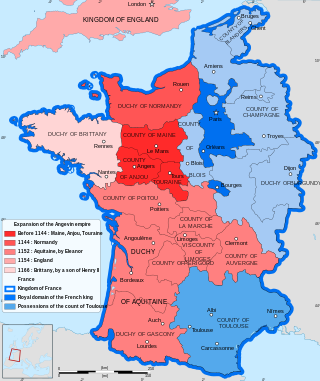
The Château de Langeais is a 15th-century Flamboyant Gothic castle in Indre-et-Loire, France, built on a promontory created by the small valley of the Roumer River at the opening to the Loire Valley. Founded in 992 by Fulk Nerra, Count of Anjou, the castle was soon attacked by Odo I, Count of Blois. After the unsuccessful attack, the now-ruined stone keep was built; it is one of the earliest datable stone examples of a keep. Between 994 and 996, the castle was besieged unsuccessfully twice more. During the conflict between the counts of Anjou and Blois, the castle changed hands several times, and in 1038 Fulk captured the castle again.

The Duchy of Brittany was a medieval feudal state that existed between approximately 939 and 1547. Its territory covered the northwestern peninsula of Europe, bordered by the Atlantic Ocean to the west, and the English Channel to the north. It was also less definitively bordered by the river Loire to the south, and Normandy, and other French provinces, to the east. The Duchy was established after the expulsion of Viking armies from the region around 939. The Duchy, in the 10th and 11th centuries, was politically unstable, with the dukes holding only limited power outside their own personal lands. The Duchy had mixed relationships with the neighbouring Duchy of Normandy, sometimes allying itself with Normandy, and at other times, such as the Breton-Norman War, entering into open conflict.

Fulk IV, called le Réchin, was the Count of Anjou from 1068 until his death. The nickname by which he is usually referred has no certain translation. Philologists have made numerous very different suggestions, including "quarreler", "rude", "sullen", "surly" and "heroic". He was noted to be "a man with many reprehensible, even scandalous, habits" by Orderic Vitalis.
Geoffrey I, also known as Geoffrey of Rennes and Geoffrey Berengar, was the eldest son of Duke Conan I of Brittany. He was Count of Rennes, by right of succession. In 992 he assumed the title of Duke of Brittany, which had long been an independent state, but he had little control over much of Lower Brittany.

Fulk III, the Black, was an early count of Anjou celebrated as one of the first great builders of medieval castles. It is estimated Fulk constructed approximately 100 castles, along with abbeys throughout the Loire Valley in what is now France. He fought successive wars with neighbors in Brittany, Blois, Poitou and Aquitaine and made four pilgrimages to Jerusalem during the course of his life. He had two wives and three children.
Fulk II of Anjou, called le Bon was Count of Anjou from 942 to his death.

Geoffrey I of Anjou, known as Grisegonelle, was count of Anjou from 960 to 987.
Ermengarde of Anjou, known as Blanche, was a Duchess consort of Burgundy. She was the daughter of Count Fulk III of Anjou and Hildegarde of Sundgau. She was sometimes known as Ermengarde-Blanche.

Odo I, Count of Blois, Chartres, Reims, Provins, Châteaudun, and Omois, was the son of Theobald I of Blois and Luitgard, daughter of Herbert II of Vermandois. He received the title of count palatine, which was traditional in his family, from King Lothair of West Francia.
Drogo was the count of Vannes and Nantes and duke of Brittany from 952, when he succeeded his father, Alan Wrybeard, until his death in 958.
Theobald I (913–975), called the Trickster, was Viscount of Blois and Viscount of Tours, and then from 956, Count of Blois, Chartres and Châteaudun, as well as Count of Tours.

Adela of Vermandois was a French noblewoman. She was Countess of Chalon and later Countess of Anjou.
Adelaide-Blanche of Anjou(c. 940 –1026) was, by her successive marriages, countess of Gévaudan and Forez, of Toulouse, of Provence, and of Burgundy, and queen of Aquitaine. She was the regent of Gevaudan during the minority of her sons in the 960s, and the regent of Provence during the minority of her son from 994 until 999.

Judith of Rennes (982–1017) was Duchess of Normandy from c. 1000 until her death.
Ermengarde of Anjou,, was the Countess of Rennes, Regent of Brittany (992–994) and also Countess of Angoulême.

The County of Anjou was a small French county that was the predecessor to the better-known Duchy of Anjou. Its capital was Angers, and its area was roughly co-extensive with the diocese of Angers. Anjou was bordered by Brittany to the west, Maine to the north, Touraine to the east and Poitou to the south. The adjectival form is Angevin, and inhabitants of Anjou are known as Angevins. In 1360, the county was raised into the Duchy of Anjou within the Kingdom of France. This duchy was later absorbed into the French royal domain in 1482 and remained a province of the kingdom until 1790.
William Taillefer, numbered William II or William IV, was the Count of Angoulême from 987. He was the son of Count Arnald II Manzer and grandson of Count William Taillefer I. He stood at the head of the family which controlled not only the Angoumois, but also the Agenais and part of Saintonge. By the time of his death he was "the leading magnate in [the west] of Aquitaine[, but his] eminence ... proved temporary and illusory," evaporating on his death in succession squabbles, revolts and the predations of his erstwhile allies. The principal sources for William's career are Ademar of Chabannes and the anonymous Historia pontificum et comitum Engolismensium.
Ermengarde of Anjou may refer to:

Alan was the only known son of Guerech, Duke of Brittany, and Aremberg. With his mother he founded the castle of Ancenis around 987, according to the Chronicle of Nantes. In 988, he succeeded his father as Count of Nantes and perhaps nominal Duke of Brittany, after his father was murdered by Count Conan I of Rennes. The following two years were marked by endless warfare between Rennes and Nantes. In 990, Alan died, either of an illness or else killed by Conan, who took Nantes and had himself proclaimed Duke of Brittany by the bishop of Nantes, Orscand de Vannes.
Geoffrey II of Thouars, was the son of Savary III. He was the viscount of Thouars from 1015 to 1043.










